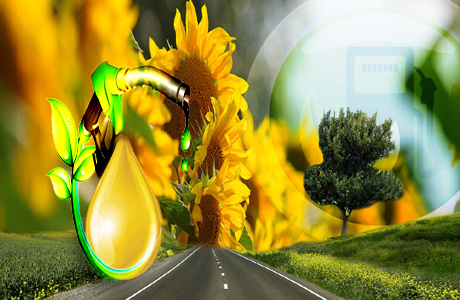Biofuels are not a green alternative
to fossil fuels
By
Andrew Steer and Craig Hanson
 Although
some forms of bioenergy can play a helpful role, dedicating
land specifically for generating bioenergy is unwise, say
WRI president Andrew Steer and global director of food,
forests & water, Craig Hanson.
Although
some forms of bioenergy can play a helpful role, dedicating
land specifically for generating bioenergy is unwise, say
WRI president Andrew Steer and global director of food,
forests & water, Craig Hanson.
Powering cars with corn and burning wood to make
electricity might seem like a way to lessen dependence on
fossil fuels and help solve the climate crisis.
But although some forms of bioenergy can play a helpful
role, dedicating land specifically for generating bioenergy
is unwise. It uses land needed for food production and
carbon storage, it requires large areas to generate just a
small amount of fuel, and it won’t typically cut greenhouse
gas emissions.
First, dedicating areas to bioenergy production increases
competition for land. Roughly three-quarters of the world’s
vegetated land is already being used to meet people’s need
for food and forest products, and that demand is expected to
rise by 70 percent or more by 2050.
Much of the rest contains natural ecosystems that keep
climate-warming carbon out of the atmosphere, protect
freshwater supplies, and preserve biodiversity.
Because land and the plants growing on it are already
generating these benefits, diverting land—even degraded,
under-utilised areas—to bioenergy means sacrificing
much-needed food, timber, and carbon storage.
Second, bioenergy production is an inefficient use of land.
While photosynthesis may do a great job of converting the
sun’s rays into food, it is an inefficient way to turn solar
radiation into non-food energy that people can use.
Thus, it takes a lot of land (and water) to yield a small
amount of fuel from plants.
In a new working paper, WRI calculates that providing
just 10 percent of the world’s liquid transportation fuel in
the year 2050 would require nearly 30 percent of all the
energy in a year’s worth of crops the world produces today.
The push for bioenergy extends beyond transportation fuels
to the harvest of trees and other sources of biomass for
electricity and heat generation.
Some research suggests that bioenergy could meet 20
percent of the world’s total annual energy demand by 2050.
Yet doing so would require an amount of plants equal to
all the world’s current crop harvests, plant residues,
timber, and grass consumed by livestock–a true non-starter.
Third, bioenergy that makes dedicated use of land does not
generally cut greenhouse gas emissions.
Burning biomass, whether directly as wood or in the form
of ethanol or biodiesel, emits carbon dioxide just like
burning fossil fuels.
In fact, burning biomass directly emits a bit more carbon
dioxide than fossil fuels for the same amount of generated
energy. But most calculations claiming that bioenergy
reduces greenhouse gas emissions relative to burning fossil
fuels do not include the carbon dioxide released when
biomass is burned.
They exclude it based on the assumption that this release
of carbon dioxide is matched and implicitly offset by the
carbon dioxide absorbed by the plants growing the biomass.
Yet if those plants were going to grow anyway, simply
diverting them to bioenergy does not remove any additional
carbon from the atmosphere and therefore does not offset the
emissions from burning that biomass.
Furthermore, when natural forests are felled to generate
bioenergy or to replace the farm fields that were diverted
to growing biofuels, greenhouse gas emissions go up.
That said, some forms of bioenergy do not increase
competition with food or land, and using them instead of
fossil fuels could reduce greenhouse gas emissions.
One example is biomass grown in excess of what would have
grown without the demand for bioenergy, such as winter cover
crops for energy.
Others include timber processing wastes, urban waste
wood, landfill methane, and modest amounts of agriculture
residues.
Using so-called second-generation technologies to convert
material such as crop residues into bioenergy has a role to
play and avoids competition for land.
A challenge will be to do this at scale, since most of
these residues are already used for animal feed or needed
for soil fertility, and others are expensive to harvest.
There are good alternatives to bioenergy made from dedicated
land. For example, solar photovoltaic (PV) cells convert
sunlight directly into energy that people can use, much like
bioenergy, but with greater efficiency and less water use.
On three-quarters of the world’s land, solar PV systems
today can generate more than 100 times the usable energy per
hectare as bioenergy.
Because electric motors can be two to three times more
efficient than internal combustion engines, solar PV can
result in 200 to 300 times as much usable energy per hectare
for vehicle transport compared to bioenergy.
One of the great challenges of our generation is how the
world can sustainably feed a population expected to reach
9.6 billion by 2050.
Using crops or land for biofuels competes with food
production, making this goal even more difficult.
The world’s land is a finite resource. As Earth becomes more
crowded, fertile land and the plants it supports become ever
more valuable for food, timber and carbon storage—things for
which we don’t have an alternative source.
February, 2015
Source:
Eco-Business